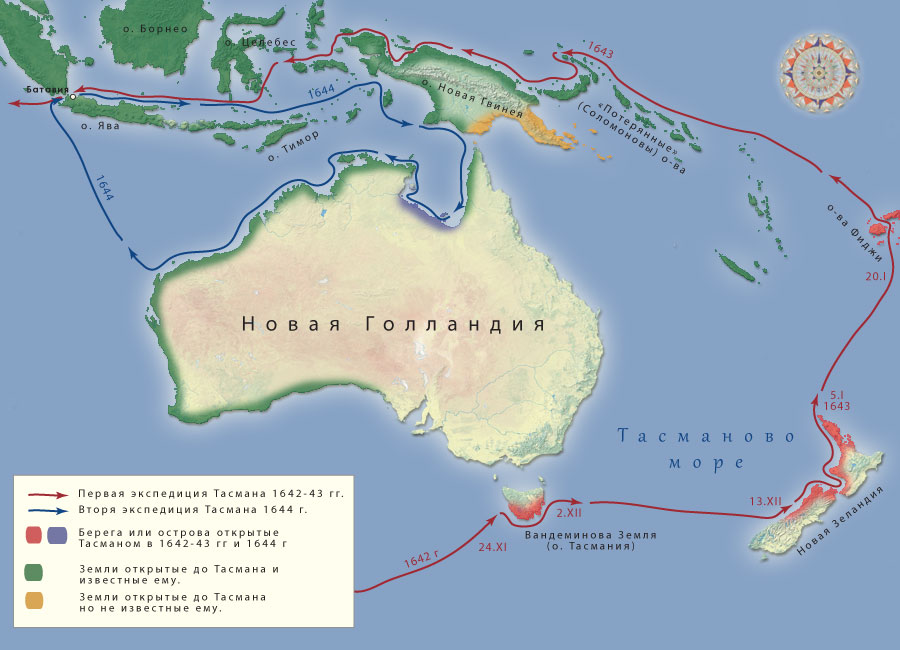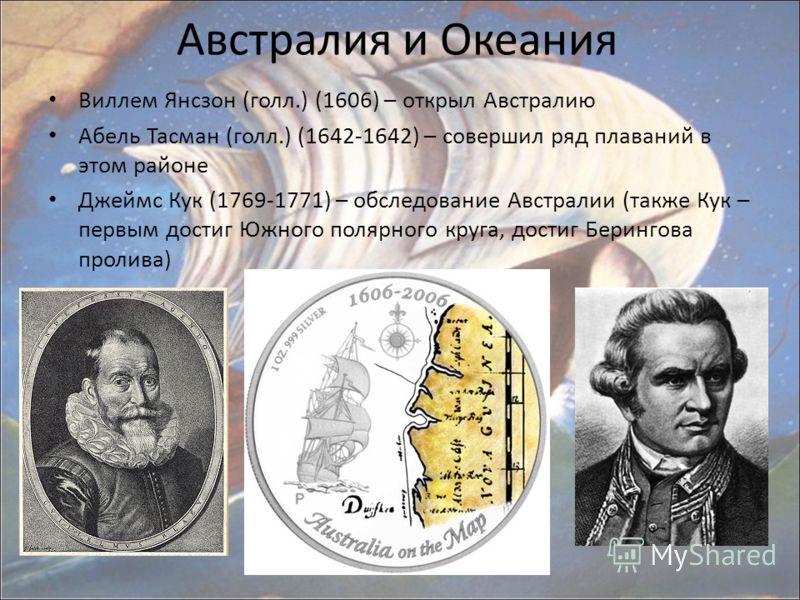TASMAN (Tasman) Abel Janszon - (1603 1659) Dutch navigator, explorer of Oceania and Australia (1644). In 1640, Tasman again led one of 11 Dutch ships heading for the shores of Japan. Around 1651, Abel Tasman retired and moved on to trade in Batavia.
Abel Janszon Tasman was born in 1603 in the village of Luthiegast near Groningen (now the municipality of Grotegast in the province of Groningen) in the Netherlands. This time he spent about three months in the Japanese port of Hirado.

During this voyage, on November 24, 1642, Tasman discovered a large island (Tasmania) off the coast of Australia and named it after Van Diemen, the governor of the Netherlands East Indies. Having traveled several tens of miles along the coast of the island, Tasman turned to the east and on December 13 saw the outlines of another unfamiliar land. It was the South Island of New Zealand. Continuing along the western coast of the island, Northern Tasman reached its tip and turned to the northeast.
After the return of the expedition to Batavia, Tasman was awarded the rank of commander and salary raised, and he himself was appointed a member of the Legal Council of Batavia. The expedition did not solve the assigned tasks, but Tasman gained additional experience and authority. One of the ships is assigned to command Abel Tasman. At the beginning of his first expedition, Tasman made a "big detour" into the Indian Ocean, reached the island of Mauritius, and from there turned east.
Dutch explorer Tasman discovered New Zealand
On January 21, 1643, the Tonga archipelago was opened, on February 6 of the same year, the Fiji Islands. From there Tasman turned back, walked along the northern coast of New Guinea and returned to Batavia on June 15.
Tasman proved that Australia is a single land mass. The sea, the bay and the island are named after him. Named after Tasman: the sea to the west of New. Zealand, the gulf and glacier on its South Island, the tip of the northwest of Australia, the Tasmanian Peninsula.
Tasman was a strong-willed, hardy and physically strong man of strong constitution, to a certain extent inclined to scientific research. During this voyage, Tasman established himself as a brilliant helmsman and an excellent commander. After 6 months at sea, the Tasman ship, having lost almost 40 of the 90 crew members, returned to the Dutch fort of Zealand on the island of Formosa (Taiwan).
Tasman discovered Tasmania, New Zealand and the Fiji Islands in 1642.
Van Diemen showed considerable interest in Seidlandt and was not disappointed by the failure of Gerrit Paul's expedition. In 1641, he decided to send a new expedition to this land and appointed Tasman as its commander. Tasman was provided with detailed instructions, which summarized the results of all voyages made in the waters of Seidlandt and the western part of the Pacific Ocean. On November 24, 1642, a very high bank was noticed. It was the southwest coast of Tasmania, an island that Tasman considered part of Seidlandt and called Vanden Land.

Passing by the Shaugen Islands and the Frey-cine Peninsula (Tasman decided it was an island), the ships reached 4Г34 ′ south latitude on December 5. During the period from 5 to 13 December 1642, the expedition crossed the sea separating Tasmania and Australia from New Zealand. At noon on December 13, Tasman and his companions discovered New Zealand land - a cape on the northwestern tip of the South Island of New Zealand, later named Cook Cape Ferwell.
On January 19, the ships entered the waters of the Tonga archipelago. Tasman was more fortunate here than Schouten and Lehmer. Tasman stayed on the islands of Tonga until February 1, 1643. The islanders received him warmly and cordially.
In 1642, Tasman was appointed commander of a detachment of two ships of the East India Company, sent to explore the southern and eastern waters of the Pacific Ocean. According to the hypotheses of geographers and navigators of that era, it was these waters that were supposed to wash the shores of the mythical Unknown Southern land, the possible wealth of which was told by several generations. While staying on this island, the Europeans first met the Maori, the indigenous people of New Zealand.
Abel Tasman - Dutch navigator
Frustrated by this incident, Tasman named this place Assassin's Cove (now Golden Bay). On January 21, 1643, the expedition reached the Tonga archipelago, discovering several previously unknown islands here. As a result, much of the coast of northern Australia was mapped for the first time. The era of the Great Geographical Discoveries ends on Tasman. Came from a poor family. In the early 30s of the seventeenth century, he entered the service of the Dutch East India Company as a simple sailor.

Abel Tasman discovered a large island south of Australia
In 1642, Dutch merchants equipped 2 ships to explore the South Pacific, searching for the legendary South Land (Southern continent) in order to find new points of commercial application. The Dutch at that time had already firmly "entrenched" in Batavia, so the expedition started from there. It was the South Island of the New Zealand archipelago. The aborigines behaved aggressively and even killed several crew members who landed on the shore. The expedition passed along the western coast of the islands and then turned northeast.
See what "Tasman" is in other dictionaries:
After returning to Batavia, Tasman receives the rank of commander, becomes an influential person in the colony. In order to find out about the events that took place on the day you are interested in, select a date in the calendar. It was only in 1853 that the present, fairer name - Tasmania - appeared on the maps. Tourism in New Zealand, Jesse Russell. Sent south from the Dutch East Indies in search of the Unknown Southern Continent.
December 13, 1642 - 370 years ago - the Dutch navigator Abel Tasman first set foot on the land of New Zealand. They explored the western coast of New Guinea and the northern coast of Australia. In the same 1643, Abel Tasman led a flotilla of three ships of the East India Company. In 1643, Tasman led a detachment of three ships from the East India Company, sailing along the western shores of New Guinea and the northern coast of Australia.




